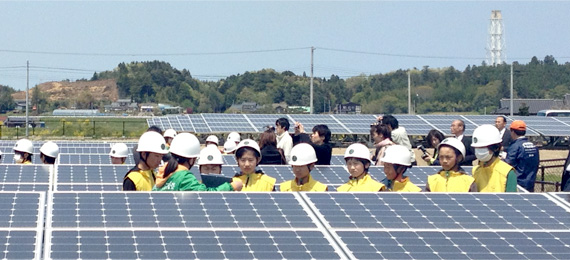Net sales from its energy systems and solutions business — which which builds solar, wind, geothermal and hydropower projects, in addition to battery-based energy storage systems and smart meters — rose approximately 6% year on year to 1085.7 billion yen ($9.9 billion).
However, “market conditions” for its solar business have “deteriorated,” the Tokyo-based group said in an online statement. The energy systems division’s operating income fell by 662.8 billion yen year on year in first nine months of fiscal 2016 to 759.8 billion yen, partly due to declining sales of its PV systems.
The Japanese group recorded a total net loss of 532.5 billion yen in the April-December 2016 period, down 53.1 billion yen from a year earlier. Its total net sales hit 3846.9 billion yen, down 166.6 billion yen from the same period a year earlier,complicating its efforts to scale down its debts and address liabilities connected to its Westinghouse Electric nuclear business in the U.S., which filed for bankruptcy protection in March.
Toshiba also attributed its poor performance to the ongoing decline of its computer and TV businesses. It recently secured shareholder approval to sell of its lucrative NAND flash memory business, amid speculation that it could be in danger of being delisted from the Tokyo Stock Exchange, as it twice postponed the release of its April-December earnings before finally posting unaudited results.
Questions over the conglomerate’s future is the second major blow to corporate Japan in less than a year, following the August 2016 acquisition of troubled electronics manufacturer and PV supplier Sharp by Taiwan’s Foxconn.
The Taipei-based manufacturer — also known as Hon Hai Precision Industry — is among several parties that have expressed interest in acquiring Toshiba’s NAND flash memory business, the sale of which could be key to the Japanese group’s survival.
Popular content
Toshiba said it has sold off roughly 160 billion yen of undisclosed assets, in addition to cuts to executive pay, to improve its financial status in the 2016 fiscal year, which ended on March 31.
The group provides residential PV systems, but only in Japan. Most of its other rooftop and ground-mounted solar projects throughout the world range in size from 500 kW to 10 MW, aside from a 50 MW array it completed in late 2014 near the Japanese city of Nagoya. The project includes 6 MW of wind capacity.
However, over the past year it has revealed plans to pair rooftop PV with storage batteries and hydrogen production capacity in Japan, in addition to supplying Integrated control systems for a virtual power plant pilot that a unit of Tokyo Electric Power (Tepco) is building in Yokohama.
And in August, Toshiba’s EPC unit agreed to work on a 33.5 MW solar project that Thailand’s Gunkul Engineering is developing in Japan’s Chiba prefecture.
This content is protected by copyright and may not be reused. If you want to cooperate with us and would like to reuse some of our content, please contact: editors@pv-magazine.com.


By submitting this form you agree to pv magazine using your data for the purposes of publishing your comment.
Your personal data will only be disclosed or otherwise transmitted to third parties for the purposes of spam filtering or if this is necessary for technical maintenance of the website. Any other transfer to third parties will not take place unless this is justified on the basis of applicable data protection regulations or if pv magazine is legally obliged to do so.
You may revoke this consent at any time with effect for the future, in which case your personal data will be deleted immediately. Otherwise, your data will be deleted if pv magazine has processed your request or the purpose of data storage is fulfilled.
Further information on data privacy can be found in our Data Protection Policy.